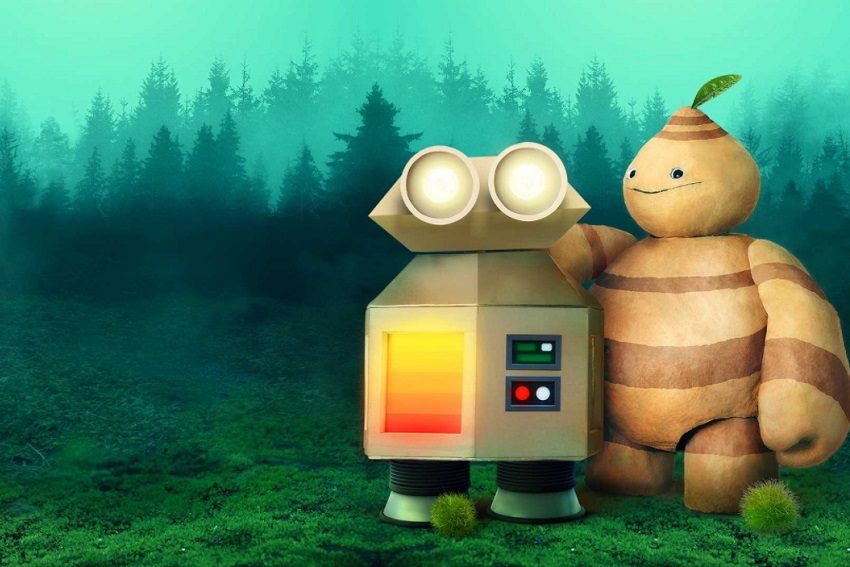Windmill Theatre's Curious Beep

Following the success of Windmill Theatre Co’s two Grug productions is the local theatre company’s latest work for young children, Beep. The show’s three creators discuss how they formed this new production about a robot girl who is a stranger in a strange land.
Windmill is one of the most fascinating Australian theatre companies. Their work, for audiences that range from toddlers to teenagers, is admired by adults due to the off-beat nature of the story-telling and eye-catching design and creations, which are bright, simple and basically works of art. Having recently experienced success with their film adaption of Girl Asleep and constant national and international touring with their litany of previous productions, Windmill returns in late August with the new work for 2017, Beep.
Created by director Sam Haren, designer Jonathon Oxlade and writer Katherine Fyffe, Beep is the story of a robot that lands in the naturalistic tree-top world of Mort’s Village and is very much an outsider. Haren (who is also the co-founder of Sandpit) and Oxlade (Windmill’s designer) worked on the two Grug shows and wanted to create an original work aimed at the same age group as Grug (which was based on the picture books by Ted Prior).
“That was the starting point of the project: could we use some of the stylistic approaches of Grug but imagine a whole new world?” Haren says.
Like other Windmill productions, Oxlade says that Beep started with a few reference images.
“Early on we were very interested in the idea of a land or a village that had lots of different sized creatures in it,” he says. “We were looking at some references of wooden-carved toys that would move.”

The two then engaged writer Fyffe — who along with Haren was one of the co-founders of the experimental theatre troupe The Border Project — to begin conceptualising the story and imagining the characters and creatures who would live in this world.
“I looked at some visual images and I thought, ‘Wow, it’s a really beautiful world’,” says Fyffe, who is the executive producer of Shaun Parker & Company. “It just struck me, what would happen if that harmonious world was disrupted by somebody or something?”
“Kath was interested in the cultural concept of: what does it mean to accept
people from other places? We’re in a world where there are all these tensions about refugees,” Haren says. “Accepting an outsider who has lost their home or world was an interesting idea to render in a very delicate, simple and subtle way.”
However, Fyffe says this theme of accepting those who are different is not overt.
“It’s more of a poetic take on big life transitions,” she says. “Transitions are a big part of the age group we’re talking to; they’re moving into kindy or they’re going to school or childcare for the first time. I was looking at what the audience might connect with. For this robot character, it’s a really massive transition to go from one place she knew was her home to a brand new place.”

Beep, like Grug and Plop, features a memorable and fun single-syllable title, and like Windmill’s other work, the images, puppets and worlds of this production are just as striking. Beep’s simplistic look is inspired by R2D2 and the robots from Douglas Trumbull’s Silent Running, while Mort’s Village has a treehouse hypercolour Ewok Village look to it. For a production such as Beep, Oxlade says communication is 50 per cent visual.
“Some of the audience may not be old enough to understand all of the language, which is usually quite simple, so you have to find clear ways to show things visually,” he says. “You have to trial everything and spend time with performers to do that, so the rehearsals for these types of shows is a little bit like animation, you storyboard it and build it that way.”
“Windmill has always valued its visual language and aesthetic,” Haren says. “If you look at all of Rose’s [Myer, Windmill’s artistic director] work, the idea of visual language is really central to all of the work she’s created for teenagers. These works by nature are very much a visual medium and I think that’s a big part of how Windmill communicates to its audiences and represents itself as a company.”

Haren believes an important part of Windmill’s success is that it avoids the dumbed-down and overly simple artifice that is usually associated with children’s theatre.
“We’ve discovered that an episodic structure is very effective for this age group, as little kids engage with narrative units rather than long, complex dramatic arcs. This show very much sets out some larger dramaturgical problems that play out but is structured in little story units designed for the performers to bring us in and out of.”
“It doesn’t patronise and doesn’t do a ‘this one’s for you’ wink to adults at the back with the prams,” Oxlade says. “The kids are in on the joke if there is a joke, and they’re with you the whole time. They’re engaged because they know what the possibilities are, and I think that’s a good sign.
“It’s also based on a reality of these characters, which is about truth and pathos, but also humour. Amongst all of this is real madness, weirdness. Things are weird because the world is … A lot of the shows might feel cartoonish but they have to contain truth and gravitas or else it doesn’t work.”
Beep
Space Theatre
Thursday, August 24 to Sunday,
September 3
windmill.org.au
Header image: Courtesy Windmill Theatre Co
Photography: Sia Duff